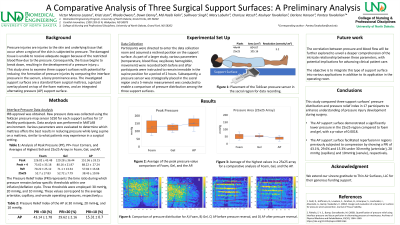Clinical Research
(CR-024) A Comparative Analysis of Three Surgical Support Surfaces: A Preliminary Analysis

Methods:
This research study aimed to compare the effectiveness of three different types of support surfaces in terms of pressure relief. The small cell alternating pressure mattress is designed with a series of thin air cells that alternate in pressure to redistribute pressure away from the patient’s body and increase blood perfusion to those areas. This is achieved by inflating some cells and deflating adjacent cells within the support surface every 5 minutes. To compare the support surfaces, we placed a thin pressure mapping sensor mat on the support surface, and we measured the pressure exerted by the patient's coccyx area at various points for a period of 5 minutes. This experiment was conducted with a sample size of 11 participants. The pressure map data was analyzed to identify the most effective support surface in reducing average pressure over the experiment time.
Results: The alternating pressure support surface was effective in reducing average pressure over the 5 minutes experiment by 10% in comparison to the gel pad and 4% with respect to the standard hospital foam surgical support surface. In addition, the alternating pressure support surface provided a higher coefficient of variation (48%) than gel (2%), and the 3-inch standard hospital foam mattress (2%), providing pressure relief of 5 minutes time, which shows the efficiency of the offloading in the alternating pressure support surface.
Discussion: Pressure ulcers have significant implications for individual patients and the healthcare system. The alternating pressure support surface provided a higher level of pressure relief, compared to the Gel and standard hospital foam support surface. The study found that the alternating pressure overlay, through periodic offloading of the sacrum, consistently reduced pressures on the sacrum compared to the Gel and foam support surfaces. These findings highlight the importance of using different cycles of pressure relief times and indicate the potential superiority of alternating pressure support in preventing pressure ulcer development.
Trademarked Items:
References:

.png)